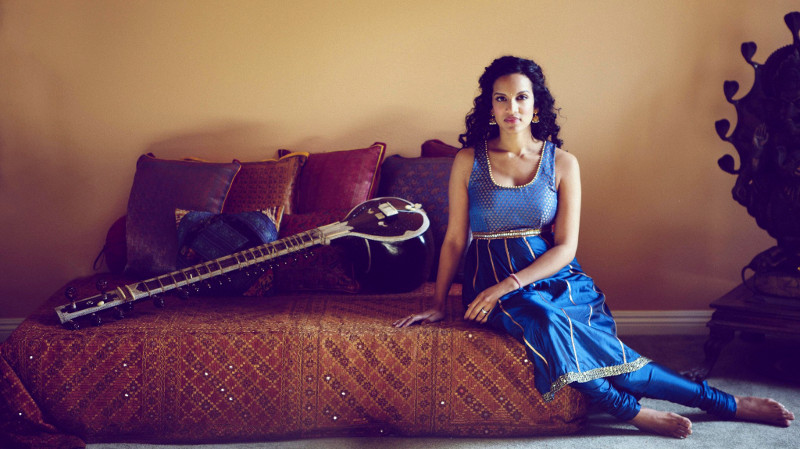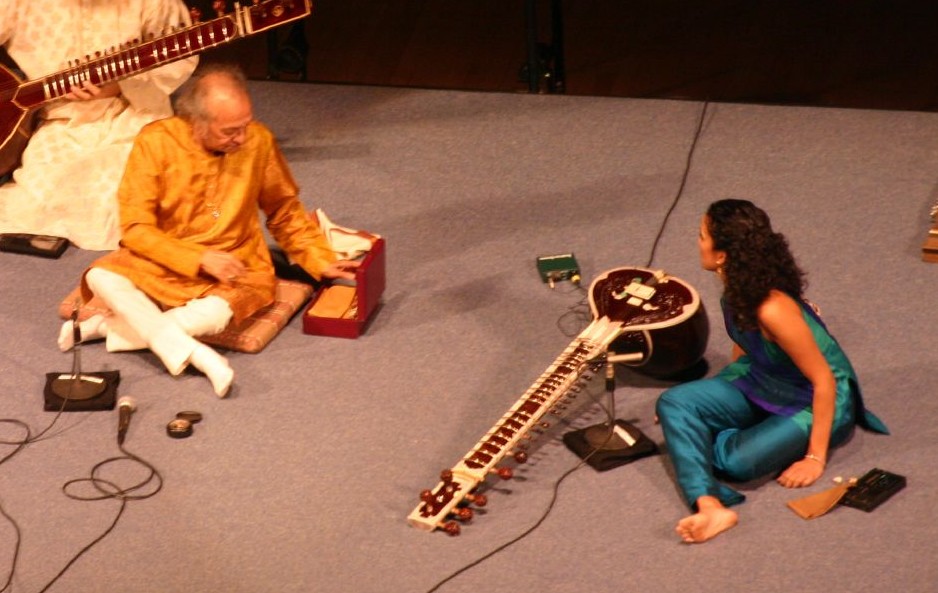
Ed. note: This story by Debra Levine, commissioned and previously published by the Younes & Soraya Nazarian Center for the Arts, is reprinted with permission.
It’s a just-released “mini-album” from a first-rate artist who’s trailing a maximal career. Anoushka Shankar, the acclaimed virtuoso of sitar, music producer, and composer, will wind up a three-week, fifteen-U.S.-city tour, with her first-ever performing date at The Soraya on October 22, 2023. On that Sunday evening, the Great Hall’s shimmering acoustics will bask in a cloud of resonant sound, as Shankar strums, plucks, teases glissandos from, and pounds percussively her instrument of choice, the nineteen-stringed Indian classical sitar with roots in medieval era.
Shankar’s Soraya debut will feature new material from her four-track album Chapter I: Forever, For Now, produced by Urdu singer Arooj Aftab, the young woman with whom Shankar collaborated on the 2023 Grammy Award-nominated song “Udhero Na” (their lithesome video here). She’ll round out the program with other repertory (“some old favorites,” she hinted in a recent Zoom call with The Soraya from London).
Chapter I: Forever, For Now charts a development in her relationship to the sitar and to a new way of writing and releasing music. Shankar calls her new sound “slightly dreamy, slightly on the gentler side” as compared to “my more furious performing moments.” A youtube video of “Daydreaming” shows Shankar, a beautiful woman with lovely brown skin, coal-black eyes, and a buoyant head of loose corkscrew curls, in her flower garden blowing soap bubbles with her two sons.
“I’m allowing a certain type of vulnerability and space, or simplicity and tenderness, to come into my playing and into my music writing,” Shankar says. Her bell-toned voice bears traces of England (where she mostly lives), India (the font of her artistic roots), and Southern California (where she maintains a home). The drive toward simplicity did not come easily, she indicated. She had to “have the courage to allow that to be, rather than dressing it up with many more layers, or coverings. To really allow naked vulnerability in my playing and the arrangements.”
Now 42, Shankar’s journey toward calm was strewn with challenges. “Over the last ten years,” she shared on Instagram in 2019, “I got sober, got married, had two boys, lost my father, made five albums, did at least six hundred shows, and saw my marriage end. In the last year alone, I moved house, got divorced and had a hysterectomy, all whilst touring, single-parenting and releasing new songs.” And that was before the pandemic. In March 2020, she saw extensive global planning for a centenary celebration of her father, Ravi Shankar, including concerts at the L.A. Phil, go up in COVID smoke.

Born of the sitar maestro when he was 61, Anoushka, starting at age nine, perched cross-legged on a floor pillow facing him, her sole pedagogue, while wrangling a kid-sized version of the typically four-foot-long instrument. By thirteen, she had her first public performances; at seventeen, the release of Anoushka, her debut album. An early childhood in London spent sparring in the family kitchen with her dry-witted “Uncle” George Harrison (Anoushka Shankar is Beatles royalty) gave way to teenaged years in Encinitas north of San Diego.
Was this avowed performer an extroverted child? Shankar pauses a beat to weigh her response. Her early days on stage, she says, “weren’t always pleasant”; indeed it was “really scary those first times that I did it.” The fact that she toured with her family, she believes, provided a comfort zone. “As a result, I had an opportunity to grow into being on stage, I think that helped me through my anxiety, rather than, I was automatically happy to be up there.”
Shankar is among the heartiest of troubadours on the road. She readily admits, “I love it. I do. I thrive on performance.” But she counters, “I can live without it; certain parts of the pandemic are a perfect example. I can definitely live many months on end without it, and even be happy. But when I get back on stage after a gap, there’s a different part of me that wakes up—it can’t exist anywhere else.”

She equally values playing major, legacy concert halls, intimate jazz clubs, or outdoor festivals. “You walk out in Orchestra Hall [Chicago], or Carnegie, or Royal Festival [London], or Sydney Opera House and they have special magic to them. But then I would really miss what it feels like to play at a festival. There’s a dynamic energy to being able to make people move and dance to your music, that’s a completely different kind of joy.”
Shankar is looking forward to playing The Soraya. “I keep hearing what a beautiful house it is,” she says. When told of The Soraya’s female architect, Kara Hill, Shankar quipped, “Then maybe we’ll have enough ladies rooms?”
So, should Soraya’ans anticipate floating away into La La Land at this concert? Absolutely not, Shankar insists: “I love getting into that dynamism and virtuosity of playing live. There is more range in a live concert. And I’m with a team of really dynamic musicians. It sounds different than it will on the recording—a lot more drama.” Anoushka Shankar realizes with a laugh, “I am quite a different animal on the stage.”
Anoushka Shankar Quintet | The Soraya | Oct 22
Arts journalist Debra Levine has been published in the New York Times, Los Angeles Times, South China Morning Post, La Opinión, Long Beach Press Telegram, Dance Magazine and more. Now in her fourth season writing program essays for The Soraya, Debra also celebrates, in 2023, fifteen years of arts blogging on artsmeme.

Excellent article